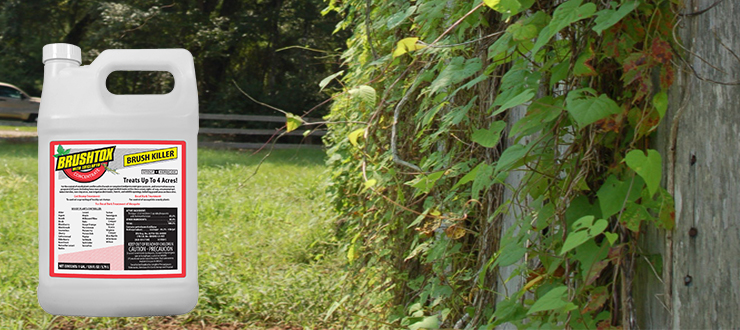
Top 5 Questions about BRUSHTOX
BRUSHTOX is one of our favorite products. It knocks out those tough woody plants on your property like mesquite, oak, locust, wild rose and sweetgum that get in the way of healthy pastures and fertile fields. In fact, BRUSHTOX kills more than 60 varieties of woody plants. This systemic herbicide also eliminates more than 30 broadleaf weeds like Canada thistle, milkweed and dog fennel. We get a lot of questions about this product, here are our top five.
1. Will BRUSHTOX kill kudzu? Yes! Kudzu is a big headache for many gardeners and farmers in the southern United States. This vining plant smothers and chokes everything in its path, including native species. It can grow 12 feet per day, eventually reaching 100 feet! BRUSHTOX can kill kudzu permanently. First cut the kudzu back then treat it with BRUSHTOX. Apply it at one quart per acre with a tank sprayer, repeating the application as necessary. BRUSHTOX can be applied to foliage, a freshly-cut stump or to the bottom 12-inches of a woody trunk. Always wear personal, protective equipment, like long-sleeved shirts and chemical-resistant gloves, and read the label carefully. Because BRUSHTOX contains triclopyr, it won’t harm most established grasses, making it ideal to use on rangeland and permanent grass pastures. BrushTox is great in the summer for brush control including Kudzu. At all times consumers should be wary of non-target plants—ie climbing on trees that might be harmed. Pastures should be sprayed using the broadcast rates in the label and the highest rate is 3 quarts per acre in whatever water need to cover that up to 150 gallons. Users should always pay attention to the warnings on the label.
2. Will BRUSHTOX control pricklypear cactus? Yes! Pricklypear is a type of succulent cacti with tall to short green to purple pads. The spines can make removing it by hand a real pain, no pun intended. Because pricklypears have roots that spread widely below the soil, treating it with an herbicide like BRUSHTOX is your best option to eradicate it from your farm or ranch. Apply one to eight quarts per acre of BRUSHTOX with enough water to thoroughly cover the pricklypear.
3. Will BRUSHTOX kill mesquite? Yes! Mesquite is one of those woody plants that BRUSHTOX was made to kill. This tree is a Western icon with wood that flavors the best barbecue. Mesquite is actually a woody legume or bush that reproduces by seed. Unfortunately, it is invading properties across the south. BRUSHTOX can be applied with a cut-stump treatment, basal-bark treatment or foliar application. Each application method is a little different, so make sure to read the label.
4. How long is the drying time for BRUSHTOX? The drying time for BRUSHTOX varies on the conditions you’re spraying in. For example, if it’s humid, it will take longer for the spray to dry. We recommend spraying when temperatures are above 60 degrees on a sunny, calm day. Use tools like the USDA Planting Zones Guide for temperature and weather conditions for application timing to achieve optimum control of your woody plants or broadleaf weeds. Keep pets out of the area until the spray has dried thoroughly. Check the label for complete instructions along with precautions.
5. Can BRUSHTOX be used for small bushes and trees? Yes! BRUSHTOX was made for small, woody bushes and trees. It can be applied to these plants as a foliar treatment, cut stump or basal bark treatment. For foliar treatments, be sure to cover the plant’s foliage thoroughly, wetting it and the root collars but not to the point of runoff. Cut stump treatments and basal bark treatments require BRUSHTOX to be mixed with oil in the spray tank or mixing tank. For cut stump, spray the stump, cut surface and root collar area of the tree. For a basal bark treatment to control woody plants with stems less than six inches, spray the basal parts of brush and tree trunks to a height of 12 to 15 inches from the ground; thoroughly wetting this zone for good control and spray to the point of runoff. Once again, check the label.
BRUSHTOX is available both locally and online. Go to our Where to Buy page to find out exactly where you can buy it!